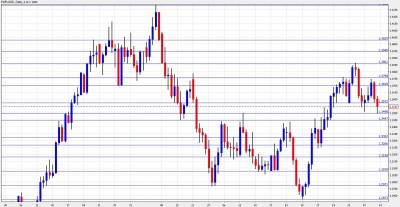Another volatile week passed on Euro traders. The upcoming week is very busy, with GDP figures expected to rock the common currency. Here’s an outlook for the European events, and an updated technical analysis for EUR/USD.
The resignation of Axel Weber from the ECB is a loss for the Euro as well, as the Bundesbank’s president is a known “hawk”. Apart from the indicators, note headlines from Ireland, Greece and Portugal – the debt crisis is still with us.
EUR/USD daily chart with support and resistance lines on it. Click to enlarge:
- Jean-Claude Trichet talks: Sunday, 17:00. The president of the ECB had his share of pushing the Euro higher and sending it lower in recent months. In a speech in Liege, Belgium, he may shed light on his views about the economic situation, inflation, employment and more, and will set the tone for the new week.
- Industrial Production: Monday, 10:00. All-European industrial output exceeded expectations and provided a lot of hope last month, with a strong rise of 1.4%. A correction is predicted this time, with a drop of 0.1%.
- French GDP: Tuesday, 6:30. Europe’s second largest economy posts its GDP before the rest of the European countries, making this release important. Growth rate in Q3 is predicted to stand at 0.6%, after a modest rate of 0.3% in Q3.
- German GDP: Tuesday, 7:00. Europe’s largest economy and powerhouse is expected to post a growth rate of 0.5% in Q4 of 2010, completing a good year. Q3 saw a rise of 0.7% and Q2 was outstanding, with a “Chinese growth rate” of 2.2%. Recent signs show that the growth rate has slowed down, but is till sufficient.
- Flash GDP: Tuesday, 10:00. Following Germany, France, Italy and other countries, the overall growth rate for the Euro-zone will probably show a rise of 0.4% in Q4, slightly faster than 0.3% in Q3. There are fears of a worse slowdown in some of the weaker countries, that will drag the figure lower.
- German ZEW Economic Sentiment: Tuesday, 10:00. Though somewhat overshadowed by the GDP releases, this important German survey of 350 analysts and investors is expected to follow the trend of recent months and advance from 15.4 to 20.2 points, showing growing confidence in the economy. The all-European figure is likely to rise from 25.4 to 31.3 points.
- Current Account: Thursday, 9:00. This figure is published a long time after the trade balance figures, yet the wide scope still provides volatility for the Euro. The large deficit of over 11 billion reported last month is likely to squeeze down to 6.1 billion and help currency.
- Consumer Confidence: Thursday, 15:00. This official from Eurostat will probably remain unchanged at -11, reflecting light pessimism. The survey of 2300 people hasn’t moved significantly in recent months.
- German PPI: Friday, 7:00. Producer prices are rising slowly, still not posing a threat. Following last month’s rise of 0.7%, a rise of 0.6% is likely now.
* All times are GMT
EUR/USD Technical Analysis
A first dip met support above 1.35, a new line that didn’t appear last week. After a rise and failure to reach the 1.3760 line, EUR/USD fell again and bounced off the 1.35 level once again to close at 1.3547.
Looking up, 1.3570 is the immediate line of resistance. It worked in both directions in recent weeks. It’s followed by 1.37 which worked in the opposite direction during October, and now switched to resistance..
Above, the role of 1.3760 is more important now, after capping the pair. Higher, 1.3860 is a strong resistance line, the highest level this year.
Further above, 1.3950 is already a more important line, after serving as a pivotal line. 1.4030, just over the round number of 1.40, served in both directions during September and October, and also beforehand. It’s a tough line.
Above, the peak of 1.4160 is another minor line before 1.4280 that is the highest level in a year and is still in the distance.
Looking down, immediate support is at 1.35, which was a double bottom just now. It’s followed by a stronger line – 1.3440 which was a very stubborn peak in the past three months now returns to be a line of resistance.
Lower, 1.3334, a peak during the summer, is a minor support line. It’s followed by 1.3267, another minor line, that worked as support a long time ago, and is still of importance.
Below, important support is found at 1.3180, which provided support during December. It’s followed by 1.3080, that prevented a full during the same period of time.
Even lower, 1.2970 was the bottom reached in November and is the next line. The last line for now is 1.2870, which is the lowest level in 5 months, reached only two weeks ago, before the impressive recovery. There are more lines further below, but they’re too far now.
I remain bearish on EUR/USD.
A higher chance of a bailout for Portugal, uncertainty regarding Irish banks, and the improvement in the US job market all weigh on the pair.
This pair receives great reviews on the web. Here are my picks:
- James Chen sees shows a head & Shoulders pattern in EUR/USD.
- Andriy Miraru provides weekly support and resistance lines for major pairs, including EUR/USD.
- Mohammed Isah marks the next levels for EUR/USD, on the downside.
- TheGeekKnows writes a review of the past week looks forward.
And yet again, when everybody’s short on the dollar, who’s left to sell?
Further reading:
-
For a broad view of all the week’s major events worldwide, read the USD outlook.
-
For the Japanese yen, read the USD/JPY forecast.
-
For GBP/USD (cable), look into the British Pound forecast.
-
For the Australian dollar (Aussie), check out the AUD to USD forecast.
-
For the New Zealand dollar (kiwi), read the NZD forecast.
-
For USD/CAD (loonie), check out the Canadian dollar.

